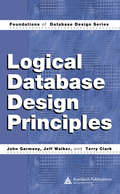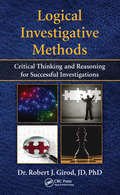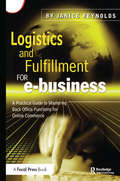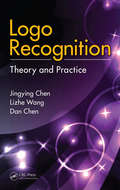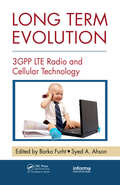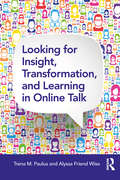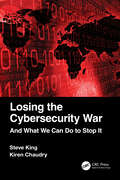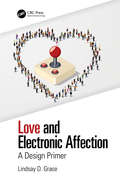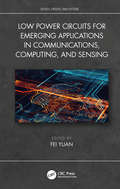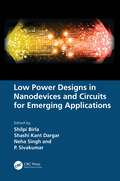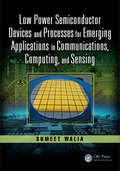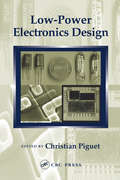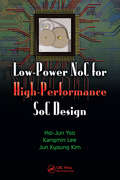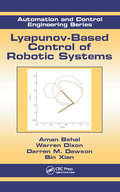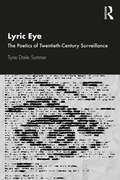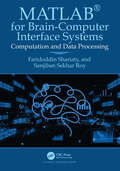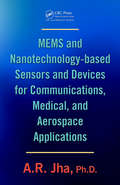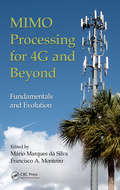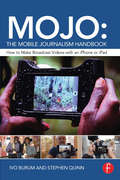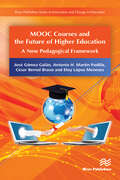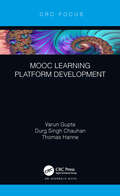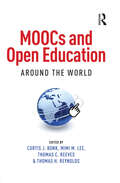- Table View
- List View
Logical Database Design Principles (Foundations Of Database Design Ser.)
by Jeff Walker Terry Clark John GarmanyUntil now, almost all books on logical database design focused exclusively on relational design. However, modern database management systems have added powerful features that have driven a movement away from truly normalized database design. Logical Database Design Principles reflects these recent changes. The book begins by covering traditional lo
Logical Investigative Methods: Critical Thinking and Reasoning for Successful Investigations
by Robert J. GirodThis book describes how to use logic, reasoning, critical thinking, and the scientific method to conduct and improve criminal and civil investigations. The author discusses how investigators and attorneys can avoid assumptions and false premises and instead make valid deductions, inductions, and inferences. He explains how tools such as interview and interrogation can be used to detect deception and profile unknown individuals and suspects. The book is aimed at improving not only the conduct of investigations, but also the logical use of cognitive, analytical, documentation, and presentation tools to win cases.
Logistics and Fulfillment for e-business: A Practical Guide to Mastering Back Office Functions for Online Commerce
by Janice ReynoldsLogistics and fulfillment management is unglamorous, complex and expensive, but it is one of the primary factors determining whether an e-business will be profitable. Many enterprises (large and small) rush into the e-business model without adequate consi
Logo Recognition: Theory and Practice
by Jingying Chen Lizhe Wang Dan ChenUsed by companies, organizations, and even individuals to promote recognition of their brand, logos can also act as a valuable means of identifying the source of a document. E-business applications can retrieve and catalog products according to their logos. Governmental agencies can easily inspect goods using smart mobile devices that use logo recognition techniques. However, because logos are two-dimensional shapes of varying complexity, the recognition process can be challenging. Although promising results have been found for clean logos, they have not been as robust for noisy logos. Logo Recognition: Theory and Practice is the first book to focus on logo recognition, especially under noisy conditions. Beginning with an introduction to fundamental concepts and methods in pattern and shape recognition, it surveys advances in logo recognition. The authors also propose a new logo recognition system that can be used under adverse conditions such as broken lines, added noise, and occlusion. The proposed system introduces a novel polygonal approximation, a robust indexing scheme, and a new line segment Hausdorff distance (LHD) matching method that can handle more distortion and transformation types than previous techniques. In the first stage, raw logos are transformed into normalized line segment maps. In the second stage, effective line pattern features are used to index the database to generate a moderate number of likely models. In the third stage, an improved LHD measure screens and generates the best matches. A comprehensive overview of logo recognition, the book also presents successful applications of the technology and suggests directions for future research.
Long Term Evolution: 3GPP LTE Radio and Cellular Technology
by Borko Furht Syed A. AhsonWhile 3G has been an outstanding success, the ever-growing demand for higher data rates and higher quality mobile communication services continues to fuel conflict between the rapidly growing number of users and limited bandwidth resources. In the future, a 100-fold increase in mobile data traffic is expected. That will necessitate further improvem
Longing, Ruin, and Connection in Hideo Kojima’s Death Stranding (Routledge Advances in Game Studies)
by Amy M. GreenThis volume provides an in-depth examination of the video game Death Stranding, focusing on the game’s exploration of ruin, nostalgia, and atonement as its primary symbolic, narrative, and mechanical language. Offering the first close examination of Death Stranding’s narrative, the book also incorporates a strong foundation in game studies, most especially related to the concepts of immersion and embodiment. The focus of the book lies in considering how Death Stranding expands on the themes of ruin, longing, and the need for connection, and whether a reconciliation—on a community level, national level, or even global level—might be possible. This book will appeal to scholars in a variety of disciplines in the Humanities and the Social Sciences, from video game studies and media studies to English, history, philosophy, and popular culture.
Looking for Insight, Transformation, and Learning in Online Talk
by Trena M. Paulus Alyssa Friend WiseLooking for Insight, Transformation, and Learning in Online Talk is a comprehensive guide to analyzing digital interaction in formal and informal online spaces. The book establishes a new research framework for addressing major challenges that have arisen as social exchanges, meaning-making, and knowledge-building increasingly take place in social media, discussion forums, and online communities. With a focus on methodological alignment to support valid and trustworthy knowledge claims, the authors present a series of design decisions to help researchers: frame their object of interest and unpack underlying assumptions understand key differences between researcher-influenced and pre-existing online talk ethically extract and organize data for analysis apply rigorous qualitative, quantitative, and computational methods to answer their research questions Written for scholars in education, business, communication, media studies, health sciences, political sciences, and beyond, this is a thorough approach to the research methods and concerns essential to the study of talk in online contexts.
Losing the Cybersecurity War: And What We Can Do to Stop It
by Steve KingThis book explains the five pillars or battlefields of cybersecurity and how a Zero Trust approach can change the advantage on each battlefield. We have taken a deep dive into each of five battlefields where we have a decided disadvantage due to constitutional structure and moral behavioral guidelines, where we provide examples of how we got here, what we can do about it, why we got here, and how we can avoid these traps in the future. This is a unique viewpoint that has never been explored – the five battlefields include Economics, Technology, Information, Education, and Leadership – and how each has contributed to our current disadvantage on the global stage. We go on to discuss how Zero Trust can change the game to create an advantage for us going forward. The credibility of Zero Trust stems directly from the father of Zero Trust, John Kindervag, who says, “And now, Steve has written a new book on Zero Trust called Losing the Cybersecurity War: And What We Can Do to Stop It. It is undeniably the best Zero Trust book yet written. While other writers have focused on implementing Zero Trust from their perspectives, Steve focuses on why Zero Trust is so important on the modern cybersecurity battlefield. His concept of the five cyber battlefields is a great insight that will help us win the cyberwar. By weaving Zero Trust principles throughout these five concepts, Steve demonstrates how the ideas and efforts involved in building Zero Trust environments will lead to a profound shift in terrain advantage. No longer will attackers own the high ground. As defenders and protectors, we can leverage modern technology in a Zero Trust way to keep our data and assets safe from infiltration and exploitation.” Steve King is the Managing Director; CyberTheory and Founder/Executive Director, CyberEd.io; cybersecurity Expert certified CISM and CISSP. He has 20 years’ experience in cybersecurity markets as CISO, CEO, and CMO; he is a Cybersecurity Technology Product and Services Sector founder and innovator; Digital Branding and Ad Agency founder, and his clients have included Starbucks, Matson, Abercrombie & Fitch, Harley Davidson, Lucky Brand, United Airlines, and Nike. He is a 3x Cybersecurity Start-up Founder and Exec, he has raised $40 million in VC, and he possesses multiple patents. Kiren Chaudry is the product manager for CyberEd.io, the leading platform for cybersecurity education.
Love and Electronic Affection: A Design Primer
by Lindsay D. GraceLove and Electronic Affection: A Design Primer brings together thought leadership in romance and affection games to explain the past, present, and possible future of affection play in games. The authors apply a combination of game analysis and design experience in affection play for both digital and analog games. The research and recommendations are intersectional in nature, considering how love and affection in games is a product of both player and designer age, race, class, gender, and more. The book combines game studies with game design to offer a foundation for incorporating affection into playable experiences. The text is organized into two sections. The first section covers the patterns and practice of love and affection in games, explaining the patterns and practice. The second section offers case studies from which designers can learn through example. Love and Electronic Affection: A Design Primer is a resource for exploring how digital relationships are offered and how to convey emotion and depth in a variety of virtual worlds. This book provides: • A catalog of existing digital and analog games for which love and affection are a primary or secondary focus. • A catalog of the uses of affection in games, to add depth and investment in both human-computer and player-to-player engagement. • Perspective on affection game analyses and design, using case studies that consider the relationship of culture and affection as portrayed in games from large scale studios to single author independent games. • Analysis and design recommendations for incorporating affection in games beyond romance, toward parental love, affection between friends, and other relationships. • Analysis of the moral and philosophical considerations for historical and planned development of love and affection in human–computer interaction. • An intersectionality informed set of scholarly perspectives from the Americas, Eurasia, and Oceania. Editor Bio: Lindsay D. Grace is Knight Chair of Interactive Media and an Associate Professor at the University of Miami School of Communication. He is Vice President for the Higher Education Video Game Alliance and the 2019 recipient of the Games for Change Vanguard award. Lindsay is author of Doing Things with Games, Social Impact through Design and more than fifty peer-reviewed papers on games and related research. He has given talks at the Game Developers Conference, SXSW, Games for Change Festival, the Online News Association, the Society for News Design, and many other industry events. He was the founding director of the American University Game Lab and Studio and the designer-developer behind several award winning games, including two affection games. He served as Vice President and on the board of directors for the Global Game Jam™ non-profit between 2014 and 2019. From 2009 to 2013 he was the Armstrong Professor at Miami University’s School of Art. Lindsay also served on the board for the Digital Games Research Association (DiGRA) between 2013 and 2015.
Low Power Circuits for Emerging Applications in Communications, Computing, and Sensing (Devices, Circuits, and Systems)
by Fei YuanThe book addresses the need to investigate new approaches to lower energy requirement in multiple application areas and serves as a guide into emerging circuit technologies. It explores revolutionary device concepts, sensors, and associated circuits and architectures that will greatly extend the practical engineering limits of energy-efficient computation. The book responds to the need to develop disruptive new system architecutres, circuit microarchitectures, and attendant device and interconnect technology aimed at achieving the highest level of computational energy efficiency for general purpose computing systems. <p><p>Features <li>Discusses unique technologies and material only available in specialized journal and conferences <li>Covers emerging applications areas, such as ultra low power communications, emerging bio-electronics, and operation in extreme environments <li>Explores broad circuit operation, ex. analog, RF, memory, and digital circuits <li>Contains practical applications in the engineering field, as well as graduate studies <li>Written by international experts from both academia and industry
Low Power Designs in Nanodevices and Circuits for Emerging Applications
by P. Sivakumar Shilpi Birla Neha Singh Shashi Kant DargarThis reference textbook discusses low power designs for emerging applications. This book focuses on the research challenges associated with theory, design, and applications towards emerging Microelectronics and VLSI device design and developments, about low power consumptions. The advancements in large-scale integration technologies are principally responsible for the growth of the electronics industry. This book is focused on senior undergraduates, graduate students, and professionals in the field of electrical and electronics engineering, nanotechnology. This book: • Discusses various low power techniques and applications for designing efficient circuits. • Covers advance nanodevices such as FinFETs, TFETs, CNTFETs. • Covers various emerging areas like Quantum-Dot Cellular Automata Circuits and FPGAs and sensors. • Discusses applications like memory design for low power applications using nanodevices. The number of options for ICs in control applications, telecommunications, high-performance computing, and consumer electronics continues to grow with the emergence of VLSI designs. Nanodevices have revolutionized the electronics market and human life; it has impacted individual life to make it more convenient. They are ruling every sector such as electronics, energy, biomedicine, food, environment, and communication. This book discusses various emerging low power applications using CMOS and other emerging nanodevices.
Low Power Semiconductor Devices and Processes for Emerging Applications in Communications, Computing, and Sensing (Devices, Circuits, and Systems)
by Sumeet WaliaThe book addresses the need to investigate new approaches to lower energy requirement in multiple application areas and serves as a guide into emerging circuit technologies. It explores revolutionary device concepts, sensors, and associated circuits and architectures that will greatly extend the practical engineering limits of energy-efficient computation. The book responds to the need to develop disruptive new system architectures and semiconductor processes aimed at achieving the highest level of computational energy efficiency for general purpose computing systems. <P><P> <li>Discusses unique technologies and material only available in specialized journal and conferences. <li>Covers emerging materials and device structures, such as ultra-low power technologies, nanoelectronics, and microsystem manufacturing. <li>Explores semiconductor processing and manufacturing, device design, and performance. <li>Contains practical applications in the engineering field, as well as graduate studies. <li>Written by international experts from both academia and industry.
Low-Power Computer Vision: Improve the Efficiency of Artificial Intelligence (Chapman & Hall/CRC Computer Vision)
by Yung-Hsiang LuEnergy efficiency is critical for running computer vision on battery-powered systems, such as mobile phones or UAVs (unmanned aerial vehicles, or drones). This book collects the methods that have won the annual IEEE Low-Power Computer Vision Challenges since 2015. The winners share their solutions and provide insight on how to improve the efficiency of machine learning systems.
Low-Power Electronics Design (Computer Engineering Series)
by Christian PiguetThe power consumption of integrated circuits is one of the most problematic considerations affecting the design of high-performance chips and portable devices. The study of power-saving design methodologies now must also include subjects such as systems on chips, embedded software, and the future of microelectronics. Low-Power Electronics Design covers all major aspects of low-power design of ICs in deep submicron technologies and addresses emerging topics related to future design. This volume explores, in individual chapters written by expert authors, the many low-power techniques born during the past decade. It also discusses the many different domains and disciplines that impact power consumption, including processors, complex circuits, software, CAD tools, and energy sources and management. The authors delve into what many specialists predict about the future by presenting techniques that are promising but are not yet reality. They investigate nanotechnologies, optical circuits, ad hoc networks, e-textiles, as well as human powered sources of energy. Low-Power Electronics Design delivers a complete picture of today's methods for reducing power, and also illustrates the advances in chip design that may be commonplace 10 or 15 years from now.
Low-Power NoC for High-Performance SoC Design (System-on-Chip Design and Technologies)
by Hoi-Jun Yoo Kangmin Lee Jun Kyong KimChip Design and Implementation from a Practical Viewpoint Focusing on chip implementation, Low-Power NoC for High-Performance SoC Design provides practical knowledge and real examples of how to use network on chip (NoC) in the design of system on chip (SoC). It discusses many architectural and theoretical studies on NoCs, including design methodology, topology exploration, quality-of-service guarantee, low-power design, and implementation trials. The Steps to Implement NoC The book covers the full spectrum of the subject, from theory to actual chip design using NoC. Employing the Unified Modeling Language (UML) throughout, it presents complicated concepts, such as models of computation and communication–computation partitioning, in a manner accessible to laypeople. The authors provide guidelines on how to simplify complex networking theory to design a working chip. In addition, they explore the novel NoC techniques and implementations of the Basic On-Chip Network (BONE) project. Examples of real-time decisions, circuit-level design, systems, and chips give the material a real-world context. Low-Power NoC and Its Application to SoC Design Emphasizing the application of NoC to SoC design, this book shows how to build the complicated interconnections on SoC while keeping a low power consumption.
Luxury Fashion Marketing and Branding: A Strategic Approach (Mastering Fashion Management)
by Alice DallabonaLuxury Fashion Marketing and Branding offers a comprehensive analysis of the key theories and concepts needed to understand the promotion of luxury fashion products. It covers subjects including luxury fashion retailing, digital marketing and communication, data analytics, emerging technologies, consumer behaviour and PR. The textbook also offers a focused discussion of the challenges faced by luxury fashion brands to meet growing customer demand for ethical and sustainable practice, including concerns related to diversity, inclusivity, and cultural sensitivity.This textbook is grounded in business practices, featuring real-world examples and international case studies from both established and modern brands. Chapter objectives and summaries aid comprehension, whilst end-of-chapter questions and activities enable further research and discussion.Luxury Fashion Marketing and Branding is ideal for advanced undergraduate and postgraduate students of fashion marketing and communications, luxury fashion business and luxury brand management. Its applied approach will also make it suitable for those studying for an Executive MBA in Fashion and Luxury Management. Online resources include an instructor’s manual, lecture slides and a test bank.
Lyapunov-Based Control of Robotic Systems
by Warren Dixon Aman Behal Darren M. Dawson Bin XianLyapunov-Based Control of Robotic Systems describes nonlinear control design solutions for problems that arise from robots required to interact with and manipulate their environments. Since most practical scenarios require the design of nonlinear controllers to work around uncertainty and measurement-related issues, the authors use Lyapunov's direc
Lyric Eye: The Poetics of Twentieth-Century Surveillance
by Tyne Daile SumnerLyric Eye: The Poetics of Twentieth-Century Surveillance presents the first detailed study of the relationship between poetry and surveillance. It critically examines the close connection between American lyric poetry and a burgeoning U.S. state surveillance apparatus from 1920 to the 1960s. The book explores the myriad ways that poets—Ezra Pound, William Carlos Williams, W.H. Auden, Langston Hughes, James Baldwin, Sylvia Plath, Gertrude Stein, Robert Lowell, Allen Ginsberg and others—explored a developing and fraught environment in which the growing power of American investigative agencies, such as the FBI under J. Edgar Hoover, imposed new pressures on cultural discourse and personal identity. In analysing twentieth-century American poetry and its various ideas about "the self," Lyric Eye demonstrates the extent to which poetry and surveillance employ similar styles of information gathering such as observation, overhearing, imitation, abstraction, repurposing of language, subversion, fragmentation and symbolism. Ground-breaking and prescient, this book will be of great interest to scholars and researchers of literature, politics, surveillance and intelligence studies, and digital humanities.
MATLAB® for Brain-Computer Interface Systems: Computation and Data Processing
by Sanjiban Sekhar Roy Faridoddin ShariatyThe book extensively explores Brain-Computer Interfaces (BCIs), emphasizing both the theoretical foundations and practical applications within this rapidly advancing field. It provides a thorough coverage of BCI fundamentals and practical implementation using MATLAB®. It begins with an introduction, covering the history of BCIs, components, and the pivotal role MATLAB® plays in their development. The book explores various aspects such as signal processing, data acquisition, rapid prototyping, machine learning, and real-time data processing, all within the MATLAB® environment. Additionally, it delves into the community and support available, along with open-source BCI toolboxes and integration with external devices. Moving forward, the book dives into the fundamentals of BCIs, including their definition, applications, principles, and components. It covers different types of brain signals utilized in BCI systems and the challenges involved in their design, such as signal reliability, userfriendliness, privacy, and regulatory issues. It discusses their principles, implementation in MATLAB®, and practical considerations for training and evaluating classification models. Finally, the book concludes with real-world case studies and practical examples, demonstrating the application of MATLAB® in BCI projects.This book is an essential reading for researchers, engineers, students, and practitioners seeking to explore the fascinating intersection of neuroscience, signal processing, and machine learning through MATLAB-based BCI development.
MEMS and Nanotechnology-Based Sensors and Devices for Communications, Medical and Aerospace Applications
by A. R. JhaThe integration of microelectromechanical systems (MEMS) and nanotechnology (NT) in sensors and devices significantly reduces their weight, size, power consumption, and production costs. These sensors and devices can then play greater roles in defense operations, wireless communication, the diagnosis and treatment of disease, and many more applicat
MIMO Processing for 4G and Beyond: Fundamentals and Evolution
by Mário Marques da Silva Francisco A. MonteiroMIMO Processing for 4G and Beyond: Fundamentals and Evolution offers a cutting-edge look at multiple-input multiple-output (MIMO) signal processing, namely its detection (in both time and frequency domains) and precoding. It examines its integration with OFDM, UWB, and CDMA, along with the impact of these combinations at the system level. Massive M
MOJO: How to Make Broadcast Videos with an iPhone or iPad
by Stephen Quinn Ivo BurumMOJO: The Mobile Journalism Handbook is the first book devoted specifically to training citizens, journalism students and media professionals to produce professional-quality videos with only a mobile device. As journalism becomes increasingly competitive, students and emerging professionals need a broader skillset to make themselves more employable, whether as mainstream or entrepreneurial journalists. This book by Dr. Ivo Burum and Dr. Stephen Quinn, world experts in mobile journalism, provides comprehensive coverage of all the skills and practices needed to be a mobile journalist. Key features: Burum and Quinn underline the importance of story and storytelling, the crucial context journalists always need to keep in mind. Other books and tutorials merely offer step-by-step guidance to mobile technology and apps. The book synthesizes the knowledge and more than 70 years of combined expertise of two of the world’s leading mobile journalism practitioners, offering sage advice and tips from people who have trained mojos in more than 20 countries. Companion Website: How-to videos on the companion website offer powerful ways for learners to absorb the content easily, walking them through the key mojo components of research, shooting, scripting, voice-over, editing and post-production. www.routledge.com/cw/burum Ivo Burum is an award-winning writer, director and television executive producer. He has more than 30 years’ experience working across genres including frontline international current affairs. A pioneer in UGS creation, Dr. Burum lectures in multimedia journalism. This is his second book about mojo. He runs Burum Media, a mojo and web TV consultancy that provides training for journalists, educators and remote communities internationally. Stephen Quinn was a journalist for 20 years before he became a university professor in 1996. Dr. Quinn taught journalism in five countries until he returned to journalism in 2011 in Hong Kong. His UK-based company MOJO Media Insights trains mobile journalists around the world. This is his twenty-first print book. He has also produced 5 iBooks. He co-writes a weekly column syndicated to seven countries.
MOOC Courses and the Future of Higher Education: A New Pedagogical Framework
by José Gómez Galán Antonio H. Padilla César Bernal BravoDuring the last decades, our society is witnessing an authentic revolution that, in a dizzying manner has deeply influenced, modified, and transformed the way of life of human beings. This constant and unstoppable revolution is transmuting all areas of our life: social, cultural, personal, labor, economic, training, etc. This new society is characterized by a high generation of knowledge and the constant and fluid processing of information. In this macro-context, the MOOC phenomenon emerged. MOOC (Massive Open Online Courses) courses are based on the principles of massive, free access to all materials and resources offered online. This new didactic path can be constituted in an innovative techno-social tendency, especially oriented in the panorama of Higher Education to stimulate university improvement, open opportunities at the same time for education and training or, simply, derive towards a new business model for the universities. In addition to being an entry point for the popularization of science and knowledge, the future possibilities are enormous and are being studied in all their various dimensions. Many initiatives as a result have been developed to implement this new form of education. MOOC Courses and the Future of Higher Education presents the latest research theories and current examples of MOOC courses practices in Higher Education. The chapters represent an extensive assortment of interpretations and practices examples of MOOC courses, across areas as varied as teaching methodologies, instructional innovations, educational technology, etc. This work is structured in three sections, the first one covers the university institution in the knowledge society, the second analyzes the MOOC training proposals, and the third discusses the future role of MOOCs. Technical topics discussed in the book include: The Virtualization of Teaching in Higher EducationTraining and Professional Development at the e-UniversityTaxonomy of MOOCsMOOC: Strengths and WeaknessesMOOCs and the Scientific Community: Challenges and InnovationMOOC PlatformsDirectory of MOOC ResourcesMOOC: Reflections of the Future
MOOC Learning Platform Development
by Thomas Hanne Varun Gupta Durg Singh ChauhanThe work presented in this book is based on empirical study undertaken as a case study to understand the challenges faced in massively open online course (MOOC) based learning and experimentation to understand the challenges for presenting theoretical and practical courses. The book proposes a flexible online platform. This solution provides flexibility in distance learning processes including course enrollment, learning, evaluation, and outcome of degrees. The proposed system not only gives students freedom to choose their courses in accordance with their needs but also use earned credit towards online degrees of any university of their choice.
MOOCs and Open Education Around the World
by Thomas C. Reeves Curtis J. Bonk Mimi M. Lee Thomas H. ReynoldsAs new digital forms of formal and informal learning proliferate, there is an increasing need to better understand how people in different regions of the world are implementing massive open online courses (MOOCs) and other forms of open educational resources (OERs). Educators, researchers, politicians, and numerous other stakeholders want to grasp what the outcomes of these initiatives are and how they can be improved. Ongoing e-learning developments related to both technology and pedagogy have pushed institutions and organizations to grapple with issues of accreditation, credentialing, quality standards, innovative assessment, and learner motivation and attrition, among other areas of concern. In response, MOOCs and Open Education Around the World explores and illuminates unique implementations of MOOCs and open education across regions and nations. The book also focuses on the various opportunities as well as the dilemmas presented in this rapidly evolving age of technology-enabled learning. What are the different delivery formats, interaction possibilities, assessment schemes, and business models? What are the key controversies or issues that must be discussed and addressed? This edited collection explains MOOCs and open education trends and issues in a variety of contexts, shares key research findings, and provides practical suggestions and recommendations for the near future.
